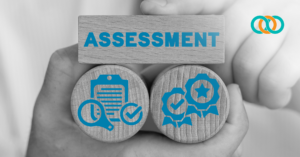Will robots replace us?
While Artificial Intelligence continues to transform corporate training, don’t expect AI to replace the valuable contributions, creativity and human reasoning of Learning & Development practitioners in the foreseeable future.
Integration of artificial intelligence into corporate Learning & Development is at the forefront of trends in digital training. From AI-powered conversation agents such as Chatbots and Virtual Assistants to augmented learning environments and a shift towards Adaptive Learning Platforms that personalize content to meet individual learner needs, accelerating advancements in artificial intelligence continue to transform and redefine workplace learning.
Yet despite the rise of generative AI in corporate training, there’s a growing need for your human knowledge, experience and expertise in L&D.
Five key areas where AI is no substitute for your human intelligence:
Passion.
Artificial Intelligence cannot comprehend emotions that drive human beings to succeed. AI lacks ambition, feels no sense of competition, and has no desire to strive for excellence. It feels no job satisfaction and does not care about the results or consequences of its work.
Only human beings possess that passion and desire for personal growth. Only real people want to contribute to the success of an organization or make a difference in the world. Only human intelligence thinks this is important.
Passion is contagious. AI is no substitute for personal role models and mentors who can augment digital training with context and coaching, team building, and the leadership that creates a culture of continuous learning and fosters the underlying human desire for meaningful work.
Emotional intelligence.
Artificial intelligence lacks empathy, compassion, or any understanding of the physical world and human heart. AI can mimic human intelligence, but cannot develop the personal relationships or build trust between people necessary for team building, sales and business success.
Robots and automation can’t compete with your human experience in areas like group dynamics or navigating the nuances of interpersonal relationships. It cannot comprehend individual emotions or motivations or know how to engage these feelings to create purposeful learning experiences.
Workplace training can help people cultivate emotional intelligence, but it’s the human instructors and instructional designers that bring this vital skill to life.
Creativity and imagination.
Artificial Intelligence is literally thinking inside the proverbial Box. AI cannot move beyond its own programming and the data it has been given.
Robots do not have the ability to imagine novel possibilities – which is the true measure of your human genius. Only human intelligence can go from brainstorming crazy and wildly impossible ideas to igniting the creative spark of innovation.
It takes imaginative, out-of-the-box thinking to meet constant changes in organizational goals and optimize the overall operational efficiency of L&D.
Common sense.
Artificial intelligence can learn things quickly, but it’s not capable of reasoning, questioning facts, or applying common sense the way you can.
Experienced and knowledgeable L&D people are essential because AI cannot see beyond the data to the practical realities of new organizational challenges or adapt to rapid changes in a dynamic, increasingly global business environment.
Common sense approaches of low-tech training methods such as reading, listening and high-touch personal interaction remain highly effective ways to captivate and motivate learners.
Soft skills.
Artificial Intelligence lacks the most desirable soft skills. This includes leadership ability, reasoning and critical thinking, interpersonal communication skills – not to mention your keen sense of humor and the wisdom that only comes from combining knowledge with experience.
Artificial Intelligence is merely a tool that you can use to complement human soft skills – and even help teach desired soft skills. Yet it cannot replicate them. If an AI algorithm does not compute unforeseen circumstances, the machinery is rendered useless.
AI also falls short of your human brain’s power to analyze, improvise, motivate and inspire people to grow beyond their own perceived limitations, and instill a desire to exceed their own expectations.
AI can enhance and facilitate Learning and Development, but only by applying your human expertise and experience.
Artificial Intelligence is great at data processing, routine task automation, predictive analysis, and providing learning analytics. This helps L&D professionals identify patterns, simulate scenarios, draw conclusions or project results, and create more effective training programs.
Artificial intelligence data and analytics can help you identify skills gaps, assist in design of tailored training, assess and improve the effectiveness of learning programs. AI is able to analyze vast amounts of data much faster than your human brain to help personalize the learning experience, as well as evaluate learner preferences, behavior, performance and progress.
But whether it’s onboarding new hires to upskilling or re-skilling current employees, many training programs that promote leadership, professional development and lifelong learning require on-going human interaction.
Without human intelligence, artificial intelligence would not exist.
Humans wrote the code, input data, created the algorithms and analysis processes of intelligent systems to crunch vast amounts of information, create powerful learning platforms and refine or update content to adapt to individual and organizational needs, forecast future skills requirements, or offer guidance on the path to continuous improvement.
AI helps drive data-driven decision making, but it will be up to your human intelligence, creativity and imagination to make the leap to find new ways forward in L&D that drives business growth.
Are you ready to select or implement AI technology into your learning programs? Let our industry-experienced Relationship Managers help you find a consultant with experience they can bring to your project. If you have more projects than people, we can provide you with the right instructional designer to start your project with confidence!
- 0share
- LinkedIn0
- Twitter0
- Facebook0
- Love This0









